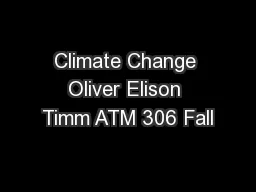

2016 Lecture 7 Indicators of climate change causes of climate change amp modeling of future climate change Objectives Introduce concepts of Climate forcing C limate sensitivity Fossil fuel consumption and ID: 777586
Download The PPT/PDF document "Climate Change Oliver Elison Timm ATM 30..." is the property of its rightful owner. Permission is granted to download and print the materials on this web site for personal, non-commercial use only, and to display it on your personal computer provided you do not modify the materials and that you retain all copyright notices contained in the materials. By downloading content from our website, you accept the terms of this agreement.
Slide1
Climate Change
Oliver Elison Timm ATM 306 Fall 2016
Lecture 7
Indicators of climate change, causes of climate change &
modeling of future climate change
Slide2Objectives
Introduce concepts of
Climate forcingC
limate sensitivity
Fossil fuel consumption and
g
reenhouse gas concentrations
Emission scenarios and Representative Concentration Pathways (RPCs)
Climate
change projections with general circulation models (GCMs
)
Slide3Reminder: What is 'climate'?
The statistical description in terms of the average and variability of relevant quantities over a period of
time
The classical period is 30 years, as defined by the World Meteorological Organization, WMO
).
These relevant quantities are most often surface variables such as temperature, precipitation, and wind
.
Climate in a wider sense is the state, including a statistical description, of the
climate system
.
Slide4What is the 'climate system‘?
The climate system is the complex system consisting of five major components: the atmosphere, the hydrosphere
, the cryosphere, the lithosphere and the biosphere
, and the interactions between them.
The
climate system
evolves in time under the influence of its own
internal dynamics
and because of
external
forcings
such as volcanic eruptions, solar variations, and human-induced
forcings
such as the changing composition of the atmosphere and land-use change.
Slide5What is 'climate change‘?
A statistically significant variation in either the mean state of the climate or in its variability, persisting for an extended period (typically decades or longer).Climate change may be due to natural internal processes or external forcings, or to persistent anthropogenic changes in the composition of the atmosphere or in land use.
Slide6“Global warming
” is an increase over time of the average temperature of Earth's atmosphere and oceans.Use of the term “global warming" generally implies a human influence — the more neutral term
“climate change” should be used for a change in climate with no presumption as to cause and no characterization of the kind of change involved.Sometimes the term "
anthropogenic climate change
" is used to indicate the presumption of human influence.
What is
‘global
w
arming
'
Slide7Burroughs, 2007
Climate variability –
Stationary climate
Climate change –
Downward trend
(e.g. cooling)
Periodic change
Abrupt change
Slide8Burroughs, 2007
Slide9An update on US public perception
Across all age groups, fewer US citizens accept global warming now than five years ago. Data taken from Pew Research (2011).
Inman, Nature Climate Change, 2012
More information shown by state (county level) can be found at
Yale’s “Climate Opinion Maps (2014)”
Slide10Across all age groups, fewer US citizens accept global warming now than five years ago. Data taken from Pew Research (2011).
More information shown by state (county level) can be found at Yale’s “Climate Opinion Maps (2014)”
Slide11Intergovernmental Panel on Climate Change (IPCC)
The IPCC was stablished by the United Nations Environment Programme
Slide12Intergovernmental Panel on Climate Change (IPCC)
Slide13Intergovernmental Panel on Climate Change (IPCC)
More than 830 Authors and Review Editors from over 80 countries were selected to form the Author teams that produced the Fifth Assessment Report (AR5).They in turn drew on the work of over 1,000 Contributing Authors and about 2,000 expert reviewers who provided over 140,000 review comments.
For the Fourth Assessment Report (AR4) released in 2007, over 3,500 experts coming from more than 130 countries contributed to the report (+450 Lead Authors, +800 Contributing Authors, and +2,500 expert reviewers providing over 90,000 review comments).
Slide14Observational evidence for climate change
The fifth assessment report of working group 1 (AR5) was published 2013
SPM
TS
Full
Report
Summary for Policymakers
(SPM)
Technical Summary
(TS)
Slide15National climate change reports:
The National Climate Assessment provides a look at climate change impacts on the U.S (published
2013/14) Similar
Slide16Observational evidence for climate change
IPCC WG1 AR, Report Ch. 2( FAQ 2.2, Fig 1)
Slide17Observational evidence for climate change
http://nca2014.globalchange.gov/report
Slide18
Slide19Spatial pattern of surface temperature changes
Slide20Spatial pattern of surface temperature changes
Slide21Spatial pattern of surface temperature changes
Slide22Spatial pattern of surface temperature changes
Slide23Slide24Slide25
Slide26Mt Pinatubo eruption
(date: 1991-06-15)
Cooling effect in an El Niño-year
Slide27The 10 warmest years on record:
http://www.climatecentral.org/gallery/graphics/10-warmest-years-globally
Slide28The 10 warmest years on record:
http://www.climatecentral.org/gallery/graphics/the-10-hottest-years-on-record(retrieved Nov 2016)
Slide29The 10 warmest years on record:
http://www.nasa.gov/press-release/nasa-noaa-analyses-reveal-record-shattering-global-warm-temperatures-in-2015
Slide30
Slide31
Slide32
Slide33
Slide34Other indicators of a globally warming climate
Slide35Other indicators of a globally warming climate
Specific humidity at surface has increased over land and ocean
Note: short records
Slide36Indicators of a globally warming climate: Global precipitation?
Slide37Pattern of Precipitation trends
Statistical tests
Slide38Atmospheric Carbon Dioxide
Background picture: source NPR
Slide39What causes the widespread warming trend and the associated environmental changes?Researchers are confronted with two questions when it comes to
observation-based climate change investigations:(a) Can we detect a change in the climate system or environment that is consistent with a global warming trend?This is the detection problem(b) Once we have found a significant change in the system, the question is:“What caused this change?”This problem (or question) is known as the
attribution problem (we need to attribute the change to the right physical cause or causes)
Slide40Global average temperature has increased by 0.85°C (1880-2012)
National Climate Assessment Report (2013)
Slide41Atmospheric Carbon Dioxide
Background picture: source NPR
Slide42Global average temperature has increased by 0.85°C (1880-2012)
National Climate Assessment Report (2013)